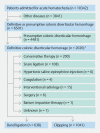Effectiveness and adverse events of endoscopic clipping versus band ligation for colonic diverticular hemorrhage: a large-scale multicenter cohort study
- PMID: 34820792
- PMCID: PMC9329063
- DOI: 10.1055/a-1705-0921
Effectiveness and adverse events of endoscopic clipping versus band ligation for colonic diverticular hemorrhage: a large-scale multicenter cohort study
Abstract
BACKGROUND : Prior studies have shown the effectiveness of both endoscopic band ligation (EBL) and clipping for colonic diverticular hemorrhage (CDH) but have been small and conducted at single centers. Therefore, we investigated which was the more effective and safe treatment in a multicenter long-term cohort study. METHODS : We reviewed data for 1679 patients with CDH who were treated with EBL (n = 638) or clipping (n = 1041) between January 2010 and December 2019 at 49 hospitals across Japan (CODE BLUE-J study). Logistic regression analysis was used to compare outcomes between the two treatments. RESULTS : In multivariate analysis, EBL was independently associated with reduced risk of early rebleeding (adjusted odds ratio [OR] 0.46; P < 0.001) and late rebleeding (adjusted OR 0.62; P < 0.001) compared with clipping. These significantly lower rebleeding rates with EBL were evident regardless of active bleeding or early colonoscopy. No significant differences were found between the treatments in the rates of initial hemostasis or mortality. Compared with clipping, EBL independently reduced the risk of needing interventional radiology (adjusted OR 0.37; P = 0.006) and prolonged length of hospital stay (adjusted OR 0.35; P < 0.001), but not need for surgery. Diverticulitis developed in one patient (0.16 %) following EBL and two patients (0.19 %) following clipping. Perforation occurred in two patients (0.31 %) following EBL and none following clipping. CONCLUSIONS : Analysis of our large endoscopy dataset suggests that EBL is an effective and safe endoscopic therapy for CDH, offering the advantages of lower early and late rebleeding rates, reduced need for interventional radiology, and shorter length of hospital stay.
The Author(s). This is an open access article published by Thieme under the terms of the Creative Commons Attribution-NonDerivative-NonCommercial License, permitting copying and reproduction so long as the original work is given appropriate credit. Contents may not be used for commercial purposes, or adapted, remixed, transformed or built upon. (https://creativecommons.org/licenses/by-nc-nd/4.0/).
Conflict of interest statement
The authors declare that they have no conflict of interest.
Figures


Comment in
-
Band ligation or clipping for diverticular bleeding: quite the quandary.Endoscopy. 2022 Mar;54(3):337. doi: 10.1055/a-1737-3935. Epub 2022 Feb 24. Endoscopy. 2022. PMID: 35203097 No abstract available.
-
Reply to Drs. Giri and Sundaram.Endoscopy. 2022 Mar;54(3):338. doi: 10.1055/a-1737-4004. Epub 2022 Feb 24. Endoscopy. 2022. PMID: 35203098 No abstract available.
-
Acute colonic diverticular haemorrhage: to band or clip?Endoscopy. 2022 Aug;54(8):745-746. doi: 10.1055/a-1774-4831. Epub 2022 Mar 7. Endoscopy. 2022. PMID: 35255525 No abstract available.
References
-
- Nagata N, Ishii N, Manabe N et al.Guidelines for colonic diverticular bleeding and colonic diverticulitis: Japan Gastroenterological Association. Digestion. 2019;99 01:1–26. - PubMed
-
- Kaise M, Nagata N, Ishii N et al.Epidemiology of colonic diverticula and recent advances in the management of colonic diverticular bleeding. Dig Endosc. 2020;32:240–250. - PubMed
-
- Nagata N, Ishii N, Kaise M et al.Long-term recurrent bleeding risk after endoscopic therapy for definitive colonic diverticular bleeding: band ligation versus clipping. Gastrointest Endosc. 2018;88:841–8.53E6. - PubMed
Publication types
MeSH terms
LinkOut - more resources
Full Text Sources
Medical

